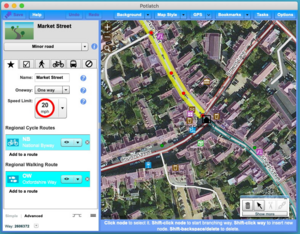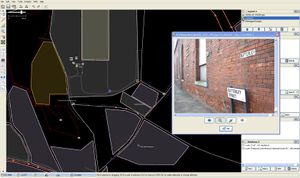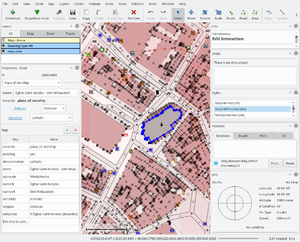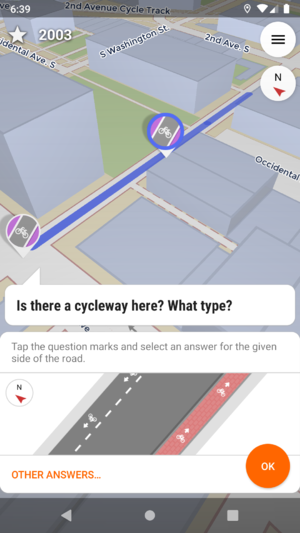Comparison of editors
Jump to navigation
Jump to search



Comparison table
| Name | For novice users | Platform | Programming language | Editor type | Development is active | Windows | Linux | Mac OS X | Android | iOS | Free | Advantages | Disadvantages |
|---|---|---|---|---|---|---|---|---|---|---|---|---|---|
| iD | yes | web based | JavaScript | fully featured | yes | yes | yes | yes | yes | yes | yes | Works almost everywhere, low entrance level | poor support for small screens such as smartphones, abstracts tagging away with sometimes confusing outcomes |
| JOSM | yes | desktop | Java | fully featured | yes | yes | yes | yes | no | no | yes | Extremely powerful and complex, highly configurable and extendable via plugins. Changeset reverting support | Extremely powerful and complex, requires JRE installation, requires learning |
| Potlatch 3 | yes | desktop | ActionScript | fully featured | yes | yes | only with WINE | yes | no | no | yes | Requires Adobe AIR runtime | |
| Merkaartor | no | desktop | C++ with Qt | fully featured | yes | yes | yes | yes | no | no | yes | Sometimes can damage relations | |
| Vespucci | no | mobile | Java | fully featured | yes | no | no | no | yes | no | yes | Allows to make all edits while surveying, without creating notes | Basically "mobile JOSM" with all disadvantages and advantages it implies. Available only for Android. |
| Go Map!! | no | mobile | Objective-C, Cocoa, and Swift | fully featured | yes | no | no | no | no | yes | yes | Allows to make all edits while surveying, without creating notes | Available only on iOS |
| StreetComplete | yes | mobile | Kotlin and Java | quests solution and overlays only | yes | no | no | no | yes | no | yes | Easiest editor available - Android phone, ability to read and OSM account are required, OSM knowledge and training to use editor is not required | Available only on Android, limited to predefined edits that refine existing objects and adding new predefined POI nodes |
| SCEE | no | mobile | Kotlin and Java | limited geometry editing, can't create ways/relations | yes | no | no | no | yes | no | yes | As with StreetComplete, but advanced functionality like raw tag editor and customs overlays requires OSM knowledge | As with StreetComplete, and also additional "expert" functionality makes it significantly more error-prone |
| OsmAnd | no | mobile | Java and C++ | map viewer with POI editing | yes | no | no | no | yes | yes | limited | Integrates with JOSM | It is mainly used for navigation instead of editing |
| Maps.Me | yes | mobile | C++ | map viewer with POI editing | yes | no | no | no | yes | yes | yes | Poor interface, limited types of objects that can be added, plus horrible privacy policy | |
| Organic Maps | yes | mobile | C++, Java, Objective C, Swift | map viewer with POI editing | yes | compiles but needs UI | compiles but needs UI | yes, but need mac with arm | yes | yes | yes | Open-source, privacy-focused, actively developed | Limited types of POI that can be added, editor UX is not improved yet |
| Locus | no | mobile | unknown | map viewer with POI editing | yes | no | no | no | yes | no | no | ||
| Level0 | no | web based | PHP | low level text-based object editing | stable, editor is completed | yes | yes | yes | yes | yes | yes | access to raw data in simplified text interface | access to raw data in simplified text interface |
| ArcGIS | no | GIS plugin | unknown | fully featured | yes | yes | yes | yes | no | no | no | Proprietary software | |
| Every Door | yes | mobile | Dart(Flutter) | map viewer with POI editing | yes | no | no | no | yes | yes | yes | Optimized for fast POI addition |
Simple online↙ editor in browser
iD

iD screenshot
- Summary
- Online editor.
- Pros
-
- It is currently the pre-set editor for www.openstreetmap.org's 'Edit' tab, and runs in your web browser
- It has a 'walkthrough' feature and has been designed to be an easy introduction for brand new OSM contributors
- A lot of effort was put into development, with significant attention paid to user experience
- Wiki help can be displayed directly in editor when editing tags
- You can use custom aerial imagery
- Street-level photos directly available in editor
- Cons
-
- It's not intended for power users (who are already excellently served by JOSM) or those who want the speed of a desktop client
- Consumes most processing power (compared with JOSM), so if the CPU/browser is slow, lags may occur
- Zooming and panning prompts a map fetch (not as fluid)
- The interface departs from normal OpenStreetMap terminology ("point", "line" and "area" instead of "node", "way" and "relation"), which can cause confusion, and editing accidents
- It is not possible to work offline
Rapid

Rapid screenshot
- Summary
- Rapid is a web-based modern editor for OpenStreetMap. Rapid integrates advanced mapping tools, authoritative geospatial open data, and cutting-edge technology to empower mappers at all levels to get started quickly, making accurate and fresh edits to maps.
- Pros
-
- Runs in any web browser, with fastest browser editor speed and responsiveness thanks to PixiJS based rendering
- Features an onboarding introduction for new users
- Is integrated with Tasking Manager software from HOTOSM and others for collaborative projects
- Is backed by a professional team including multiple web developers, UX researchers, and several regular OSM contributors with data and community expertise
- Developer team is more available and responsive to feature requests and evolving the editor for future use cases
- Has all features of iD editor as of April 2023, plus extra features and increased performance
- Allows editing when zoomed out to city scale
- Provides extra data sources for users to validate one-by-one, including AI-generated buildings and roads, and authoritative open GIS data
- Mapillary photos directly available in editor with special collaboration directly to Mapillary development team for future compatibility
- Cons
-
- Not overly specialized with power user features that would be seen in JOSM
- Requires web connection and does not work offline
- Can risk users working too quickly and not taking care to validate individual objects from external sources, despite the UX being designed for 1-by-1 validation
- Is not yet visible in OpenStreetMap.org
- Lacks open data or AI data in some countries
- not mobile device friendly
Desktop↙ and offline↙
JOSM
- Summary
- JOSM offers a large set of features and useful tools for a wide range of editing styles: It will either read in GPX tracks from your hard disk, or download them from OSM. Aerial imagery can easily be downloaded as a background for tracing. JOSM also supports photo mapping and audio mapping. Once you have completed your edits, you can upload them to OSM.
- Pros
-
- Fast fluid panning and zooming. Near-infinite zooming for super-precise mapping.
- Highly configurable and extendible via plugins, Map Styles, Presets or Validator Rules .
- Advanced editing functionality e.g. changeset reverting.
- A big selection of aerial imagery and third-party GPS traces immediately available as backgrounds for tracing. Custom TMS, WMS and WMTS aerial imagery can be added too (please check the permissions).
- Built in validator, which checks for common mapping errors before data upload
- Can work offline using downloaded data files, and can work with local photo and GPX files
- Tags are shown to user directly. Many tags are recognized by the "presets" which then show description, a translated/localized form and links to the OSM wiki page about a tag for more info.
- Very active development. Bugs are often fixed fast and a new stable version with new features appears usually every month.
- Cons
-
- The finer points of the interface take a while to learn.
- You have to download the software to run it, unlike the following online options (although there is a "Java Web Start" option)
- It requires Java 11 or better to work (not a big problem for most people).
- No help text when editing tags
Merkaartor
- Summary
- Merkaartor is a fully featured editor for OpenStreetMap available under the GNU General Public License and developed using the Qt toolkit.
- Pros
-
- Has some unique features like transparent display of map features like roads and true curved roads.
- Intuitive user interface
- Binaries for Windows, Mac OS X and some Linux platforms are available. Source for the rest.
- Easy to set up satellite imagery from Bing or any other WMS/TMS source.
- Tag styles can be customized
- Save rendered maps as SVG or bitmap graphic
- Cons
-
- Merkaartor development is a bit slow, which makes bugfixes and new features available only by grabbing the source.
- Small userbase. Developer community is tiny.
- Slow on large number of loaded gps points.
Potlatch 3

Potlatch 3 screenshot. Showing OSM data and background imagery
- Summary
- Adobe AIR desktop editor (replacement of Potlatch2).
- Pros
-
- Not currently available via the 'Edit' tab's drop-down arrow
- Familiar interface inherited from Potlatch2 suitable for both beginners & advanced users
- Modeless user interace
- Displaying of GPS traces in a separate layer
- Some advanced features including vector backgrounds, tasks, and merging/conflation functionality for specialists
- Several aerial imagery backgrounds preconfigured and option for custom TMS imagery (please check the permissions)
- Cons
-
- Requires a flash runtime
- does not work offline
- Beta development stage
Mobile
Vespucci
- Summary
- Vespucci is the only full OpenStreetMap editor for Android. It is also the first one, having been available and developed since 2009.
- Pros
- mobility
- a full editor for OpenStreetMap that works both on small (phones) and large (tablet) screen Android devices
- supports editing with keyboard and mouse if available
- create/edit nodes, ways, tags, and relations, with all the usual geometry related operations
- built-in support for Imagery Offset Database
- all editing can be done on the ground - no need to rely on memory
- helpful lead developer who is considerate of users' input
- useful display of all the changes you have made, down to a tag- and relation-level diff
- support for offline editing with pre-downloaded dataset in progress
- Cons
- UI can sometimes be a little dated-looking, and clumsy/cryptic to use
- Not currently ideal for editing of large relations (e.g. routes)
- No built-in object history at the moment (opens osm.org history in browser)
- Bad mobile data coverage will bring your mobile survey-edit session to a halt (unless you downloaded the area in advance; see also Pro #9)
Go Map!!
- Summary
- Go Map!! is an iOS app that lets you create and edit information in OpenStreetMap. Go Map!! supports editing nodes and ways and arbitrary tagging.
- Pros
-
- Mobile
- Clean but powerful UI
- Filterable objects to improve load speeds
- Utilizes the preset library from iD
- User friendly Turn Restriction editing GUI
- Ability to clear caches for imagery, OSM data, GPX Traces and more
- Continuous OSM data download
- Cons
-
- Can be resource intensive when cache gets large
- Clunky workflow to edit most relation types
StreetComplete
- Summary
- StreetComplete is a specialized editor of OpenStreetMap data. It allows to easily add some specific information.
- Pros
-
- Mobility.
- Very easy to add predefined data - user is asked simple questions, easy to verify for somebody near object, app handles entirety of tagging and making edit
- allows to create notes
- Ability to edit without Internet connection - quests and map may be cached
- Cons
-
- Is not intended as a general purpose editor, only adding of predefined data and answering notes is available
SCEE
- Summary
- SCEE is an "Expert Edition" fork of StreetComplete, enhanced with raw tag editor, custom overlays, custom quests, Osmose problem detection and more.
- Pros
-
- Mobility.
- Very easy to add predefined data (as in StreetComplete), but also allows full range of custom tags and customizable ways to display data
- allows to create notes (with pictures)
- toggleable satellite view in addition to regular OSM vector display
- Ability to edit without Internet connection - quests and map may be cached
- Cons
-
- more advanced editing features it incorporates make them harder to learn and significantly more prone to human errors than StreetComplete
- While more advanced than StreetComplete, it is still not a general purpose editor (editing geometries is limited, and there is no way to create new ways/relations, only nodes)
OsmAnd
- Summary
- Navigation app that allows you to add, delete or change POIs.
- Pros
-
- Fully offline
- Relatively simple user interface
- Also supports Notes
- Cons
-
- Node and closed way edits only (and only for common tag combinations)
- Offline means time lag: downloaded map might be old, might take some time for user to upload changes
- Editing on a mapview, not a dataview. So you might add things that are there but not rendered.
- Usually no sat pic background, so POIs might be some distance from real location.
Every Door
- Summary
- Mobile editor for adding shops and amenities, but also addresses or street objects
- Pros
-
- Optimised to add shops or amenities quickly, for instance when walking along a street with several shops
- Ability to edit without Internet connection - quests and map may be cached
- Ample choice of presets and ability
- User can use aerial imagery or osm-carto to be sure to locate POI correctly
- Can create notes
- Cons
-
- Even on relative large screens (5.65") it might be difficult to tap the right object accurately
GIS
ArcGIS Editor for OSM
- Summary
- ESRI has released a plugin for editing OSM data.
- Pros
-
- Industry standard GIS Program
- Very comprehensive GIS capabilities
- Cons
-
- Proprietary
- "ArcGIS for Home Use" will cost you 100$/year
- Works only with ArcGIS 10
- Editing relations are not supported
See also
- Editors — list of different editors (many others not described here)
- Software — list of other software categories including mobile apps (some of which have editing functionality)
- Comparison of discontinued editors — old sections moved off this page
- Change rollback — lists some special editors/methods for reverting / undeletion
- Component overview — Technical overview of OpenStreetMap showing how editors fit in
- Editor usage stats - how often various editors are used




